Abstract
Serum antibodies to exotoxin A and type-specific lipopolysaccharide were measured by passive hemagglutination in 52 patients with Pseudomonas aeruginosa septicemia. Their comparative protective activities were evaluated by relating the titers of each at the onset of bacteremia to subsequent outcome. High acute serum antitoxin and antilipopolysaccharide titers (log2 reciprocal mean titers greater than 5) were associated with survival (76% of 17 with high vs. 46% of 24 with low antitoxin titers, P = 0.05; 85% of 13 with high vs. 48% of 29 with low antilipopolysaccharide titers, P = 0.03). In contrast, neither antibody titer was significantly associated (P less than or equal to 0.05) with patients' age or sex, severity of underlying disease, presence of leukopenia, steroid or immunosuppressive therapy. Despite a correlation between acute titers of the two antibodies (r = 0.33, P = 0.06), they appeared to protect independently and additively. Whereas 75% of 8 patients with high antitoxin titers and only 38% of 16 with low titers survived with low antilipopolysaccharide titers (P = 0.10), 100% (6/6), 73% (8/11), and 38% (6/16) survived, respectively, when both, one, or neither antibody was present in high titer (P = 0.01). Furthermore, the association between high acute serum antitoxin titers and survival was more pronounced in patients with rapidly fatal underlying disease (P = 0.06) and leukopenia (P = 0.12) than in more favorable prognostic and immune categories. These data indicate that serum antibodies to exotoxin A and lipopolysaccharide are found in most patients with P. aeruginosa septicemia and both are protective. Both antibodies may have therapeutic or prophylactic potential, whereas serum antiexotoxin A antibodies may be particularly beneficial in compromised hosts.
Full text
PDF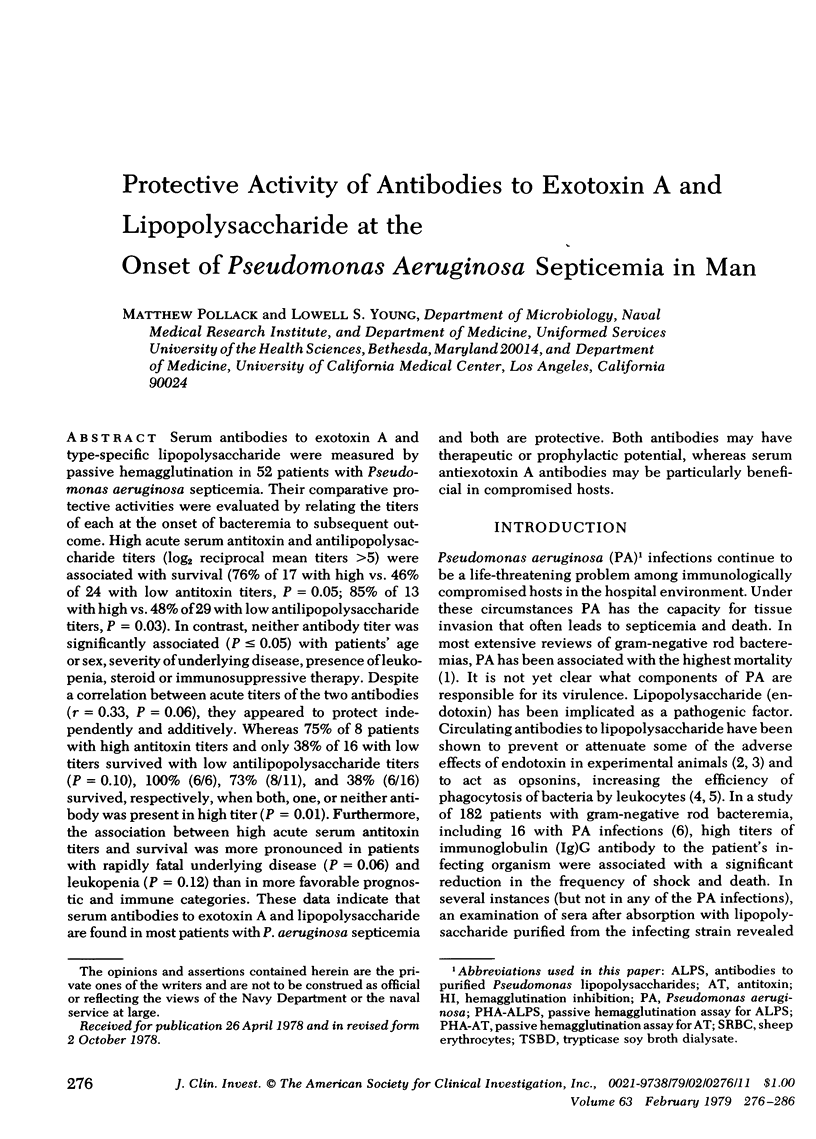
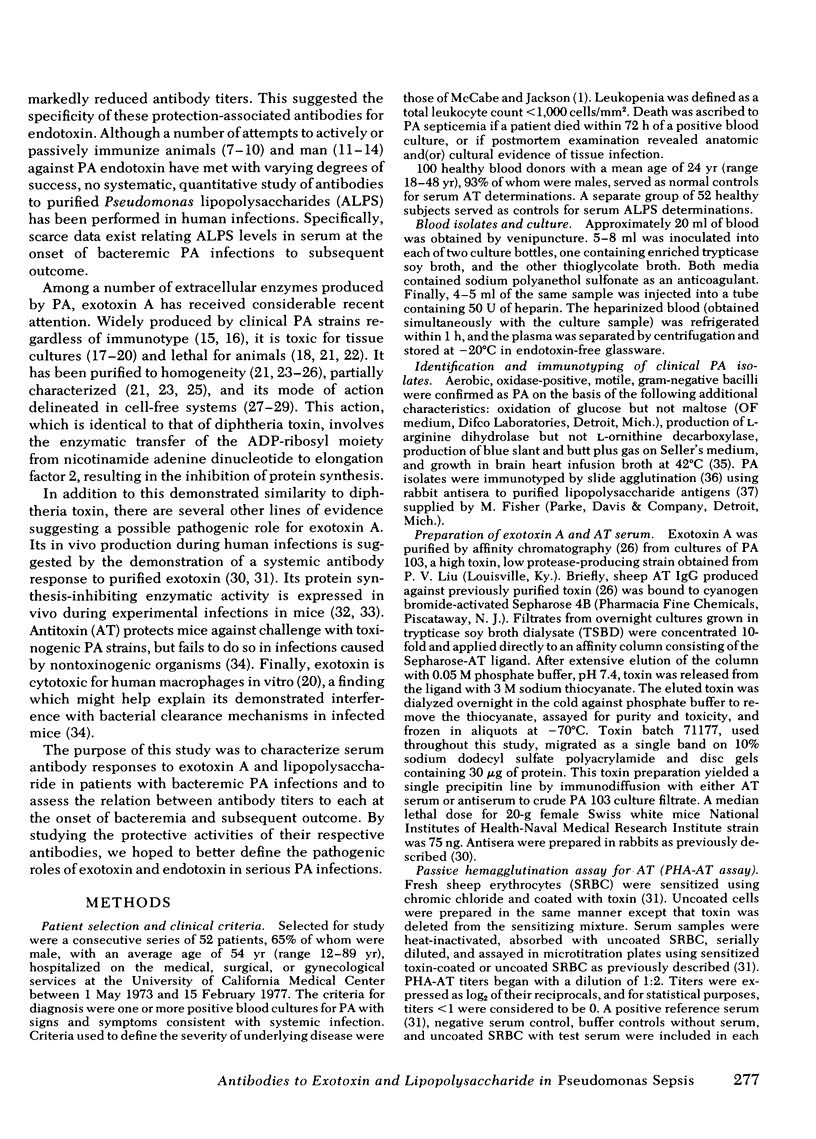
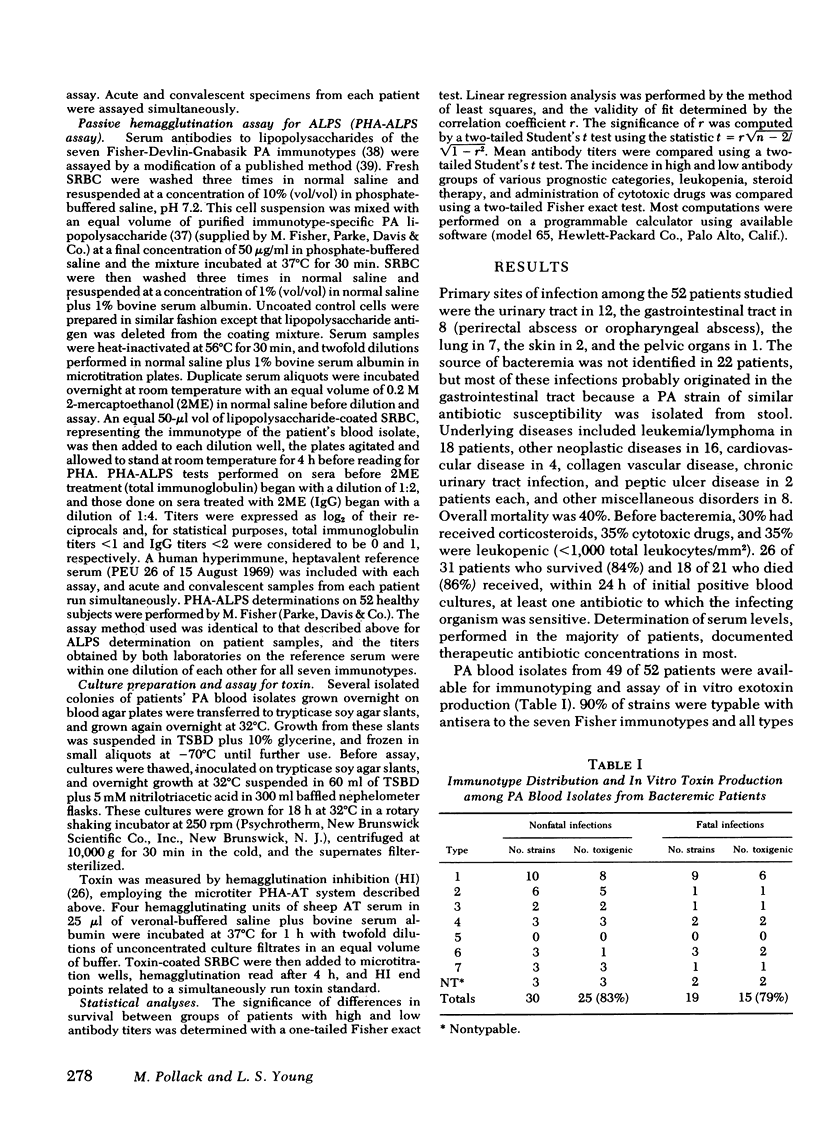
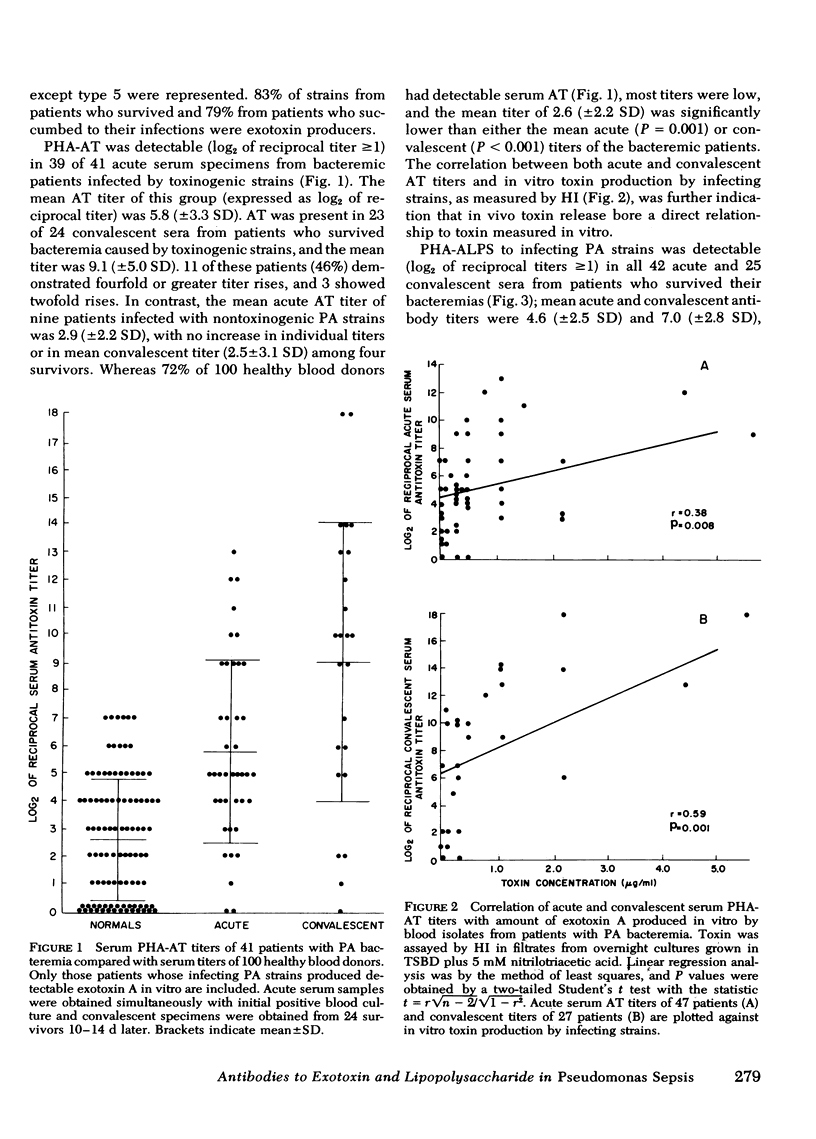
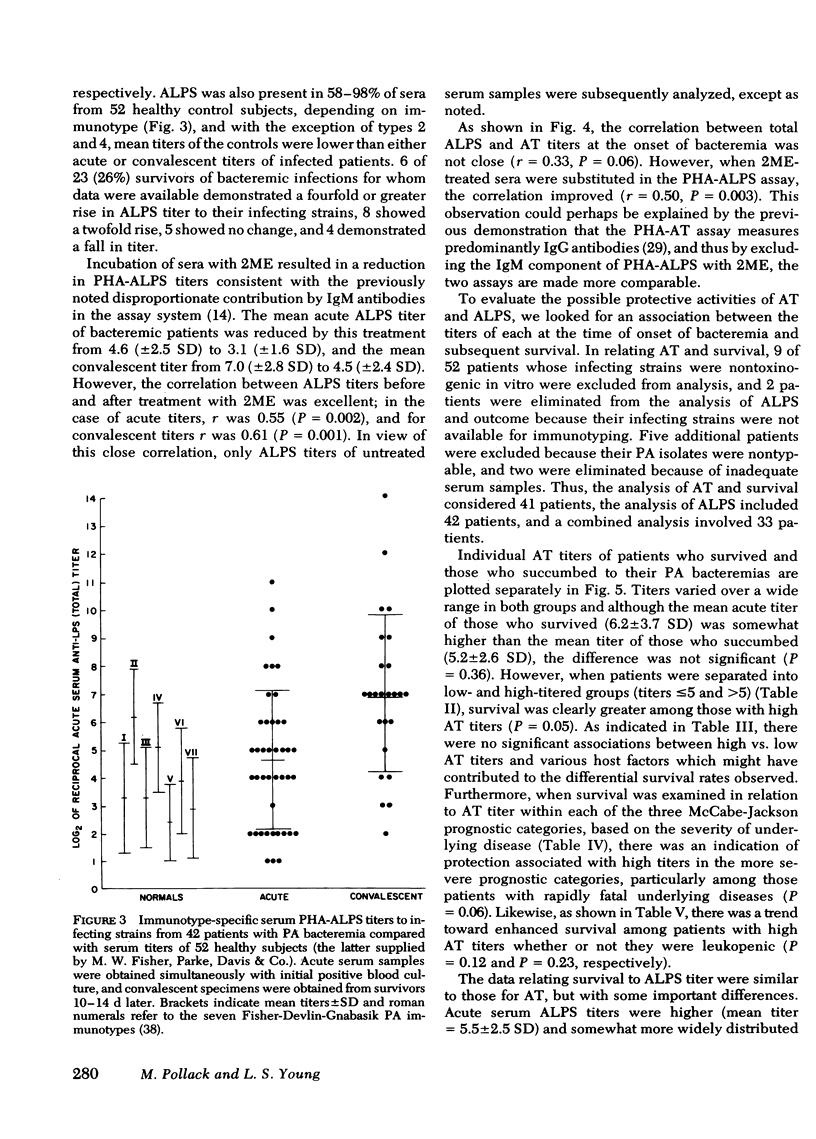
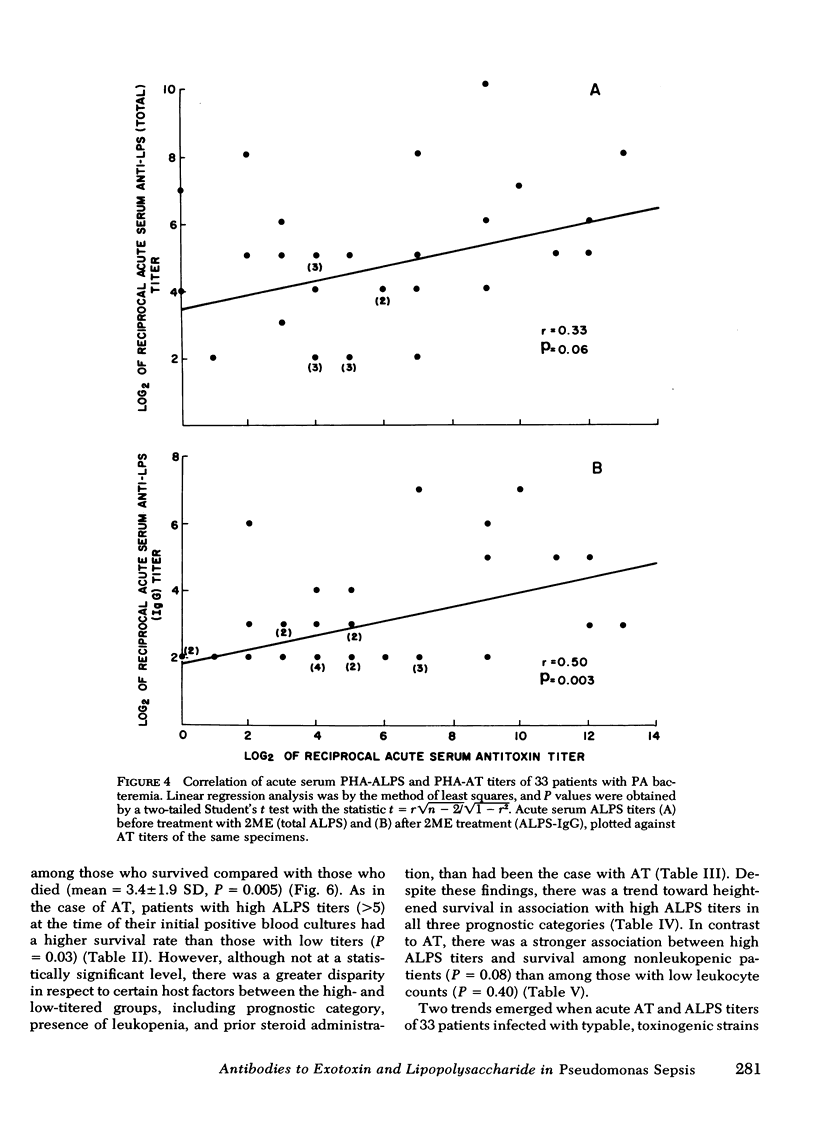
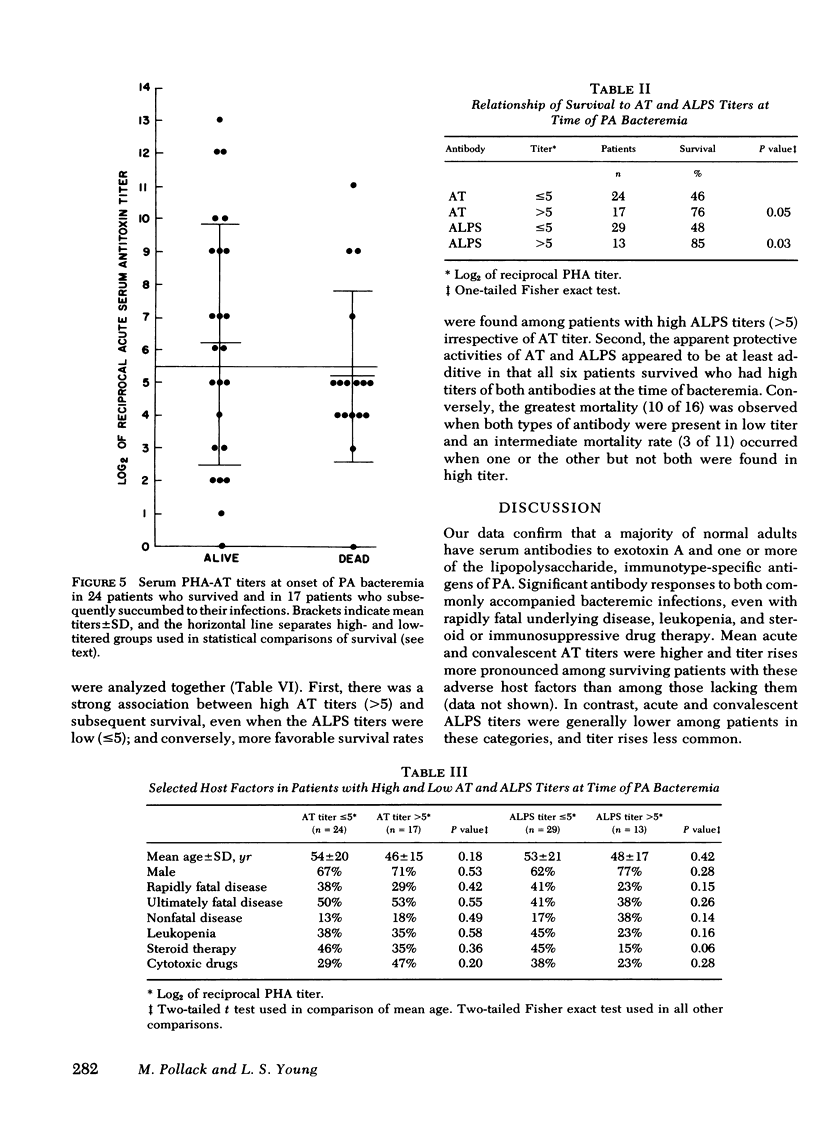
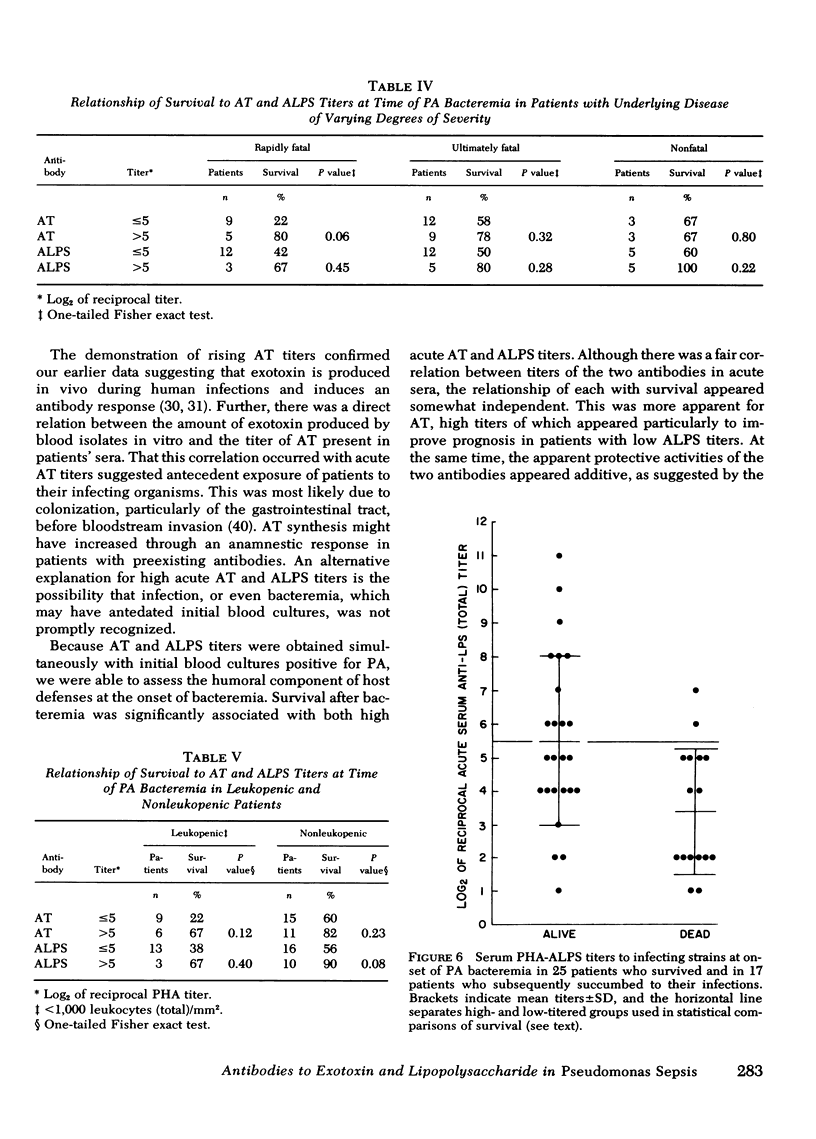
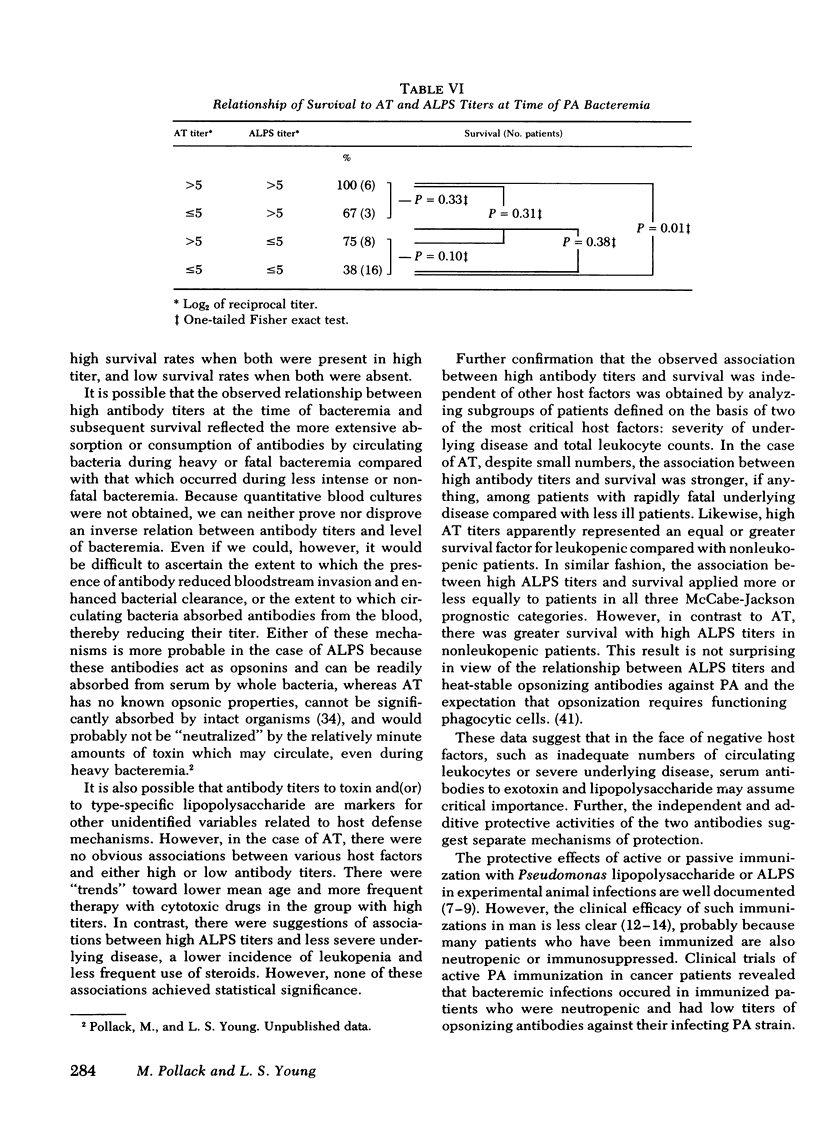
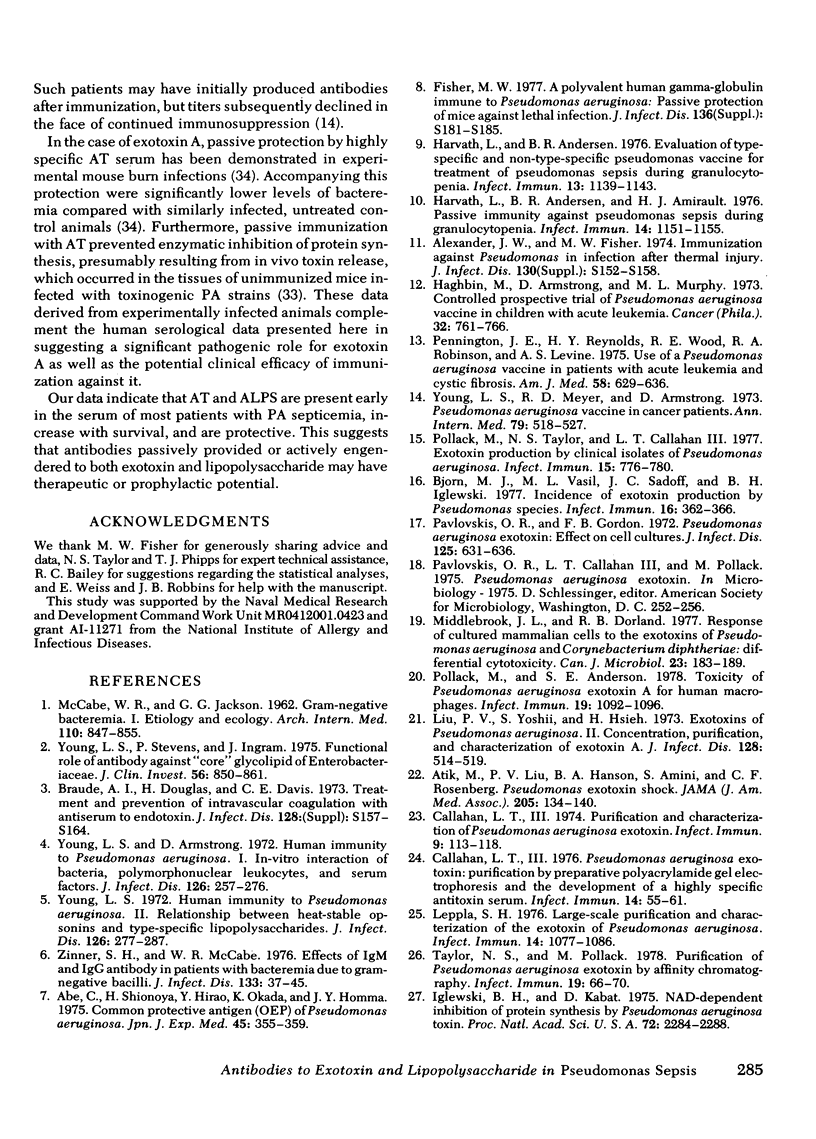
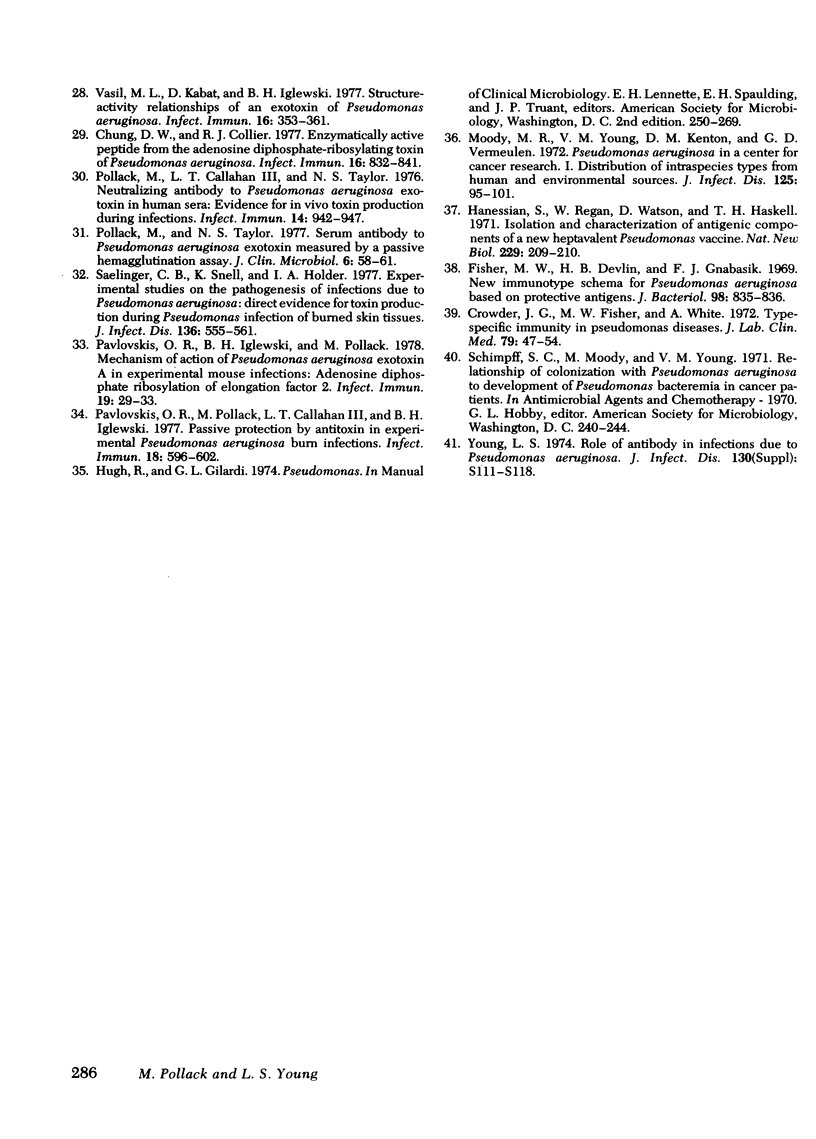
Selected References
These references are in PubMed. This may not be the complete list of references from this article.
- Abe C., Shionoya H., Hirao Y., Okada K., Homma J. Y. Common protective antigen (OEP) of Pseudomonas aeruginosa. Jpn J Exp Med. 1975 Oct;45(5):355–359. [PubMed] [Google Scholar]
- Bjorn M. J., Vasil M. L., Sadoff J. C., Iglewski B. H. Incidence of exotoxin production by Pseudomonas species. Infect Immun. 1977 Apr;16(1):362–366. doi: 10.1128/iai.16.1.362-366.1977. [DOI] [PMC free article] [PubMed] [Google Scholar]
- Callahan L. T., 3rd Pseudomonas aeruginosa exotoxin: purification by preparative polyacrylamide gel electrophoresis and the development of a highly specific antitoxin serum. Infect Immun. 1976 Jul;14(1):55–61. doi: 10.1128/iai.14.1.55-61.1976. [DOI] [PMC free article] [PubMed] [Google Scholar]
- Callahan L. T., 3rd Purification and characterization of Pseudomonas aeruginosa exotoxin. Infect Immun. 1974 Jan;9(1):113–118. doi: 10.1128/iai.9.1.113-118.1974. [DOI] [PMC free article] [PubMed] [Google Scholar]
- Chung D. W., Collier R. J. Enzymatically active peptide from the adenosine diphosphate-ribosylating toxin of Pseudomonas aeruginosa. Infect Immun. 1977 Jun;16(3):832–841. doi: 10.1128/iai.16.3.832-841.1977. [DOI] [PMC free article] [PubMed] [Google Scholar]
- Crowder J. G., Fisher M. W., White A. Type-specific immunity in pseudomonas diseases. J Lab Clin Med. 1972 Jan;79(1):47–54. [PubMed] [Google Scholar]
- Fisher M. W., Devlin H. B., Gnabasik F. J. New immunotype schema for Pseudomonas aeruginosa based on protective antigens. J Bacteriol. 1969 May;98(2):835–836. doi: 10.1128/jb.98.2.835-836.1969. [DOI] [PMC free article] [PubMed] [Google Scholar]
- Haghbin M., Armstrong D., Murphy M. L. Controlled prospective trial of Pseudomonas aeruginosa vaccine in children with acute leukemia. Cancer. 1973 Oct;32(4):761–766. doi: 10.1002/1097-0142(197310)32:4<761::aid-cncr2820320405>3.0.co;2-h. [DOI] [PubMed] [Google Scholar]
- Hanessian S., Regan W., Watson D., Haskell T. H. Isolation and characterization of antigenic components of a new heptavalent Pseudomonas vaccine. Nat New Biol. 1971 Feb 17;229(7):209–210. doi: 10.1038/newbio229209a0. [DOI] [PubMed] [Google Scholar]
- Harvath L., Andersen B. R., Amirault H. J. Passive immunity against pseudomonas sepsis during granulocytopenia. Infect Immun. 1976 Nov;14(5):1151–1155. doi: 10.1128/iai.14.5.1151-1155.1976. [DOI] [PMC free article] [PubMed] [Google Scholar]
- Harvath L., Andersen B. R. Evaluation of type-specific and non-type-specific pseudomonas vaccine for treatment of pseudomonas sepsis during granulocytopenia. Infect Immun. 1976 Apr;13(4):1139–1143. doi: 10.1128/iai.13.4.1139-1143.1976. [DOI] [PMC free article] [PubMed] [Google Scholar]
- Iglewski B. H., Kabat D. NAD-dependent inhibition of protein synthesis by Pseudomonas aeruginosa toxin,. Proc Natl Acad Sci U S A. 1975 Jun;72(6):2284–2288. doi: 10.1073/pnas.72.6.2284. [DOI] [PMC free article] [PubMed] [Google Scholar]
- Leppla S. H. Large-scale purification and characterization of the exotoxin of Pseudomonas aeruginosa. Infect Immun. 1976 Oct;14(4):1077–1086. doi: 10.1128/iai.14.4.1077-1086.1976. [DOI] [PMC free article] [PubMed] [Google Scholar]
- Liu P. V., Yoshii S., Hsieh H. Exotoxins of Pseudomonas aeruginosa. II. Concentration, purification, and characterization of exotoxin A. J Infect Dis. 1973 Oct;128(4):514–519. doi: 10.1093/infdis/128.4.514. [DOI] [PubMed] [Google Scholar]
- Middlebrook J. L., Dorland R. B. Response of cultured mammalian cells to the exotoxins of Pseudomonas aeruginosa and Corynebacterium diphtheriae: differential cytotoxicity. Can J Microbiol. 1977 Feb;23(2):183–189. doi: 10.1139/m77-026. [DOI] [PubMed] [Google Scholar]
- Moody M. R., Young V. M., Kenton D. M., Vermeulen G. D. Pseudomonas aeruginosa in a center for cancer research. I. Distribution of intraspecies types from human and environmental sources. J Infect Dis. 1972 Feb;125(2):95–101. doi: 10.1093/infdis/125.2.95. [DOI] [PubMed] [Google Scholar]
- Pavlovskis O. R., Gordon F. B. Pseudomonas aeruginosa exotoxin: effect on cell cultures. J Infect Dis. 1972 Jun;125(6):631–636. doi: 10.1093/infdis/125.6.631. [DOI] [PubMed] [Google Scholar]
- Pavlovskis O. R., Iglewski B. H., Pollack M. Mechanism of action of Pseudomonas aeruginosa exotoxin A in experimental mouse infections: adenosine diphosphate ribosylation of elongation factor 2. Infect Immun. 1978 Jan;19(1):29–33. doi: 10.1128/iai.19.1.29-33.1978. [DOI] [PMC free article] [PubMed] [Google Scholar]
- Pavlovskis O. R., Pollack M., Callahan L. T., 3rd, Iglewski B. H. Passive protection by antitoxin in experimental Pseudomonas aeruginosa burn infections. Infect Immun. 1977 Dec;18(3):596–602. doi: 10.1128/iai.18.3.596-602.1977. [DOI] [PMC free article] [PubMed] [Google Scholar]
- Pennington J. E., Reynolds H. Y., Wood R. E., Robinson R. A., Levine A. S. Use of a Pseudomonas Aeruginosa vaccine in pateints with acute leukemia and cystic fibrosis. Am J Med. 1975 May;58(5):629–636. doi: 10.1016/0002-9343(75)90498-2. [DOI] [PubMed] [Google Scholar]
- Pollack M., Anderson S. E., Jr Toxicity of Pseudomonas aeruginosa exotoxin A for human macrophages. Infect Immun. 1978 Mar;19(3):1092–1096. doi: 10.1128/iai.19.3.1092-1096.1978. [DOI] [PMC free article] [PubMed] [Google Scholar]
- Pollack M., Callahan L. T., 3rd, Taylor N. S. Neutralizing antibody to Pseudomonas aeruginosa exotoxin in human sera: evidence for in vivo toxin production during infection. Infect Immun. 1976 Oct;14(4):942–947. doi: 10.1128/iai.14.4.942-947.1976. [DOI] [PMC free article] [PubMed] [Google Scholar]
- Pollack M., Taylor N. S., Callahan L. T., 3rd Exotoxin production by clinical isolates of pseudomonas aeruginosa. Infect Immun. 1977 Mar;15(3):776–780. doi: 10.1128/iai.15.3.776-780.1977. [DOI] [PMC free article] [PubMed] [Google Scholar]
- Pollack M., Taylor N. S. Serum antibody to Pseudomonas aeruginosa exotoxin measured by a passive hemagglutination assay. J Clin Microbiol. 1977 Jul;6(1):58–61. doi: 10.1128/jcm.6.1.58-61.1977. [DOI] [PMC free article] [PubMed] [Google Scholar]
- Saelinger C. B., Snell K., Holder I. A. Experimental studies on the pathogenesis of infections due to Pseudomonas aeruginosa: direct evidence for toxin production during Pseudomonas infection of burned skin tissues. J Infect Dis. 1977 Oct;136(4):555–561. doi: 10.1093/infdis/136.4.555. [DOI] [PubMed] [Google Scholar]
- Schimpff S. C., Moody M., Young V. M. Relationship of colonization with Pseudomonas aeruginosa to development of Pseudomonas bacteremia in cancer patients. Antimicrob Agents Chemother (Bethesda) 1970;10:240–244. [PubMed] [Google Scholar]
- Taylor N. S., Pollack M. Purification of Pseudomonas aeruginosa exotoxin by affinity chromatography. Infect Immun. 1978 Jan;19(1):66–70. doi: 10.1128/iai.19.1.66-70.1978. [DOI] [PMC free article] [PubMed] [Google Scholar]
- Vasil M. L., Kabat D., Iglewski B. H. Structure-activity relationships of an exotoxin of Pseudomonas aeruginosa. Infect Immun. 1977 Apr;16(1):353–361. doi: 10.1128/iai.16.1.353-361.1977. [DOI] [PMC free article] [PubMed] [Google Scholar]
- Wesley J., Fisher A., Fisher M. W. Immunization against Pseudomonas in infection after thermal injury. J Infect Dis. 1974 Nov;130 (Suppl)(0):S152–S158. doi: 10.1093/infdis/130.supplement.s152. [DOI] [PubMed] [Google Scholar]
- Young L. S., Armstrong D. Human immunity to Pseudomonas aeruginosa. I. In-vitro interaction of bacteria, polymorphonuclear leukocytes, and serum factors. J Infect Dis. 1972 Sep;126(3):257–276. doi: 10.1093/infdis/126.3.257. [DOI] [PubMed] [Google Scholar]
- Young L. S. Human immunity to Pseudomonas aeruginosa. II. Relationship between heat-stable opsonins and type-specific lipopolysaccharides. J Infect Dis. 1972 Sep;126(3):277–287. doi: 10.1093/infdis/126.3.277. [DOI] [PubMed] [Google Scholar]
- Young L. S., Meyer R. D., Armstrong D. Pseudomonas aeruginosa vaccine in cancer patients. Ann Intern Med. 1973 Oct;79(4):518–527. doi: 10.7326/0003-4819-79-4-518. [DOI] [PubMed] [Google Scholar]
- Young L. S. Role of antibody in infections due to Pseudomonas aeruginosa. J Infect Dis. 1974 Nov;130 (Suppl)(0):S111–S118. doi: 10.1093/infdis/130.supplement.s111. [DOI] [PubMed] [Google Scholar]
- Young L. S., Stevens P., Ingram J. Functional role of antibody against "core" glycolipid of Enterobacteriaceae. J Clin Invest. 1975 Oct;56(4):850–861. doi: 10.1172/JCI108164. [DOI] [PMC free article] [PubMed] [Google Scholar]
- Zinner S. H., McCabe W. R. Effects of IgM and IgG antibody in patients with bacteremia due to gram-negative bacilli. J Infect Dis. 1976 Jan;133(1):37–45. doi: 10.1093/infdis/133.1.37. [DOI] [PubMed] [Google Scholar]


